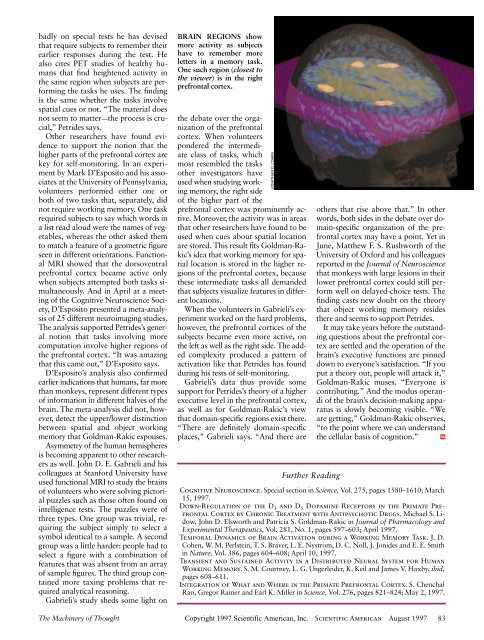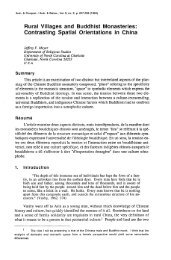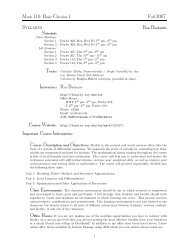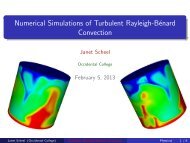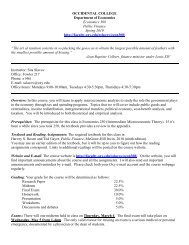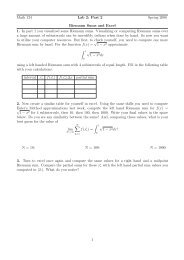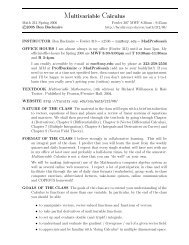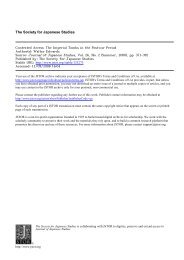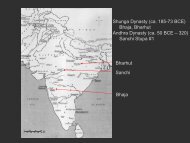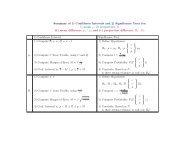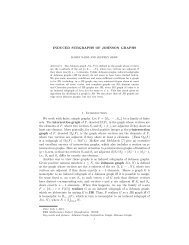The Machinery of Thought
The Machinery of Thought
The Machinery of Thought
Create successful ePaper yourself
Turn your PDF publications into a flip-book with our unique Google optimized e-Paper software.
adly on special tests he has devisedthat require subjects to remember theirearlier responses during the test. Healso cites PET studies <strong>of</strong> healthy humansthat find heightened activity inthe same region when subjects are performingthe tasks he uses. <strong>The</strong> findingis the same whether the tasks involvespatial cues or not. “<strong>The</strong> material doesnot seem to matter—the process is crucial,”Petrides says.Other researchers have found evidenceto support the notion that thehigher parts <strong>of</strong> the prefrontal cortex arekey for self-monitoring. In an experimentby Mark D’Esposito and his associatesat the University <strong>of</strong> Pennsylvania,volunteers performed either one orboth <strong>of</strong> two tasks that, separately, didnot require working memory. One taskrequired subjects to say which words ina list read aloud were the names <strong>of</strong> vegetables,whereas the other asked themto match a feature <strong>of</strong> a geometric figureseen in different orientations. FunctionalMRI showed that the dorsoventralprefrontal cortex became active onlywhen subjects attempted both tasks simultaneously.And in April at a meeting<strong>of</strong> the Cognitive Neuroscience Society,D’Esposito presented a meta-analysis<strong>of</strong> 25 different neuroimaging studies.<strong>The</strong> analysis supported Petrides’s generalnotion that tasks involving morecomputation involve higher regions <strong>of</strong>the prefrontal cortex. “It was amazingthat this came out,” D’Esposito says.D’Esposito’s analysis also confirmedearlier indications that humans, far morethan monkeys, represent different types<strong>of</strong> information in different halves <strong>of</strong> thebrain. <strong>The</strong> meta-analysis did not, however,detect the upper/lower distinctionbetween spatial and object workingmemory that Goldman-Rakic espouses.Asymmetry <strong>of</strong> the human hemispheresis becoming apparent to other researchersas well. John D. E. Gabrieli and hiscolleagues at Stanford University haveused functional MRI to study the brains<strong>of</strong> volunteers who were solving pictorialpuzzles such as those <strong>of</strong>ten found onintelligence tests. <strong>The</strong> puzzles were <strong>of</strong>three types. One group was trivial, requiringthe subject simply to select asymbol identical to a sample. A secondgroup was a little harder: people had toselect a figure with a combination <strong>of</strong>features that was absent from an array<strong>of</strong> sample figures. <strong>The</strong> third group containedmore taxing problems that requiredanalytical reasoning.Gabrieli’s study sheds some light onBRAIN REGIONS showmore activity as subjectshave to remember moreletters in a memory task.One such region (closest tothe viewer) is in the rightprefrontal cortex.the debate over the organization<strong>of</strong> the prefrontalcortex. When volunteerspondered the intermediateclass <strong>of</strong> tasks, whichmost resembled the tasksother investigators haveused when studying workingmemory, the right side<strong>of</strong> the higher part <strong>of</strong> theprefrontal cortex was prominently active.Moreover, the activity was in areasthat other researchers have found to beused when cues about spatial locationare stored. This result fits Goldman-Rakic’sidea that working memory for spatiallocation is stored in the higher regions<strong>of</strong> the prefrontal cortex, becausethese intermediate tasks all demandedthat subjects visualize features in differentlocations.When the volunteers in Gabrieli’s experimentworked on the hard problems,however, the prefrontal cortices <strong>of</strong> thesubjects became even more active, onthe left as well as the right side. <strong>The</strong> addedcomplexity produced a pattern <strong>of</strong>activation like that Petrides has foundduring his tests <strong>of</strong> self-monitoring.Gabrieli’s data thus provide somesupport for Petrides’s theory <strong>of</strong> a higherexecutive level in the prefrontal cortex,as well as for Goldman-Rakic’s viewthat domain-specific regions exist there.“<strong>The</strong>re are definitely domain-specificplaces,” Gabrieli says. “And there areJONATHAN D. COHENFurther Readingothers that rise above that.” In otherwords, both sides in the debate over domain-specificorganization <strong>of</strong> the prefrontalcortex may have a point. Yet inJune, Matthew F. S. Rushworth <strong>of</strong> theUniversity <strong>of</strong> Oxford and his colleaguesreported in the Journal <strong>of</strong> Neurosciencethat monkeys with large lesions in theirlower prefrontal cortex could still performwell on delayed-choice tests. <strong>The</strong>finding casts new doubt on the theorythat object working memory residesthere and seems to support Petrides.It may take years before the outstandingquestions about the prefrontal cortexare settled and the operation <strong>of</strong> thebrain’s executive functions are pinneddown to everyone’s satisfaction. “If youput a theory out, people will attack it,”Goldman-Rakic muses. “Everyone iscontributing.” And the modus operandi<strong>of</strong> the brain’s decision-making apparatusis slowly becoming visible. “Weare getting,” Goldman-Rakic observes,“to the point where we can understandthe cellular basis <strong>of</strong> cognition.”SACognitive Neuroscience. Special section in Science, Vol. 275, pages 1580–1610; March15, 1997.Down-Regulation <strong>of</strong> the D 1 and D 5 Dopamine Receptors in the Primate PrefrontalCortex by Chronic Treatment with Antipsychotic Drugs. Michael S. Lidow,John D. Elsworth and Patricia S. Goldman-Rakic in Journal <strong>of</strong> Pharmacology andExperimental <strong>The</strong>rapeutics, Vol. 281, No. 1, pages 597–603; April 1997.Temporal Dynamics <strong>of</strong> Brain Activation during a Working Memory Task. J. D.Cohen, W. M. Perlstein, T. S. Braver, L. E. Nystrom, D. C. Noll, J. Jonides and E. E. Smithin Nature, Vol. 386, pages 604–608; April 10, 1997.Transient and Sustained Activity in a Distributed Neural System for HumanWorking Memory. S. M. Courtney, L. G. Ungerleider, K. Keil and James V. Haxby, ibid,pages 608–611.Integration <strong>of</strong> What and Where in the Primate Prefrontal Cortex. S. ChenchalRao, Gregor Rainer and Earl K. Miller in Science, Vol. 276, pages 821–824; May 2, 1997.<strong>The</strong> <strong>Machinery</strong> <strong>of</strong> <strong>Thought</strong> Copyright 1997 Scientific American, Inc. Scientific American August 1997 83


